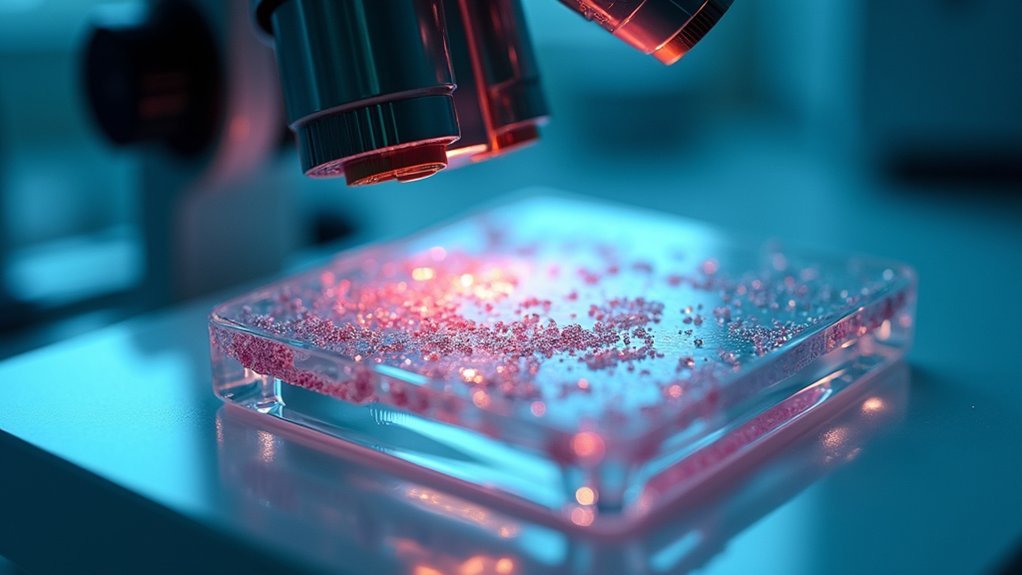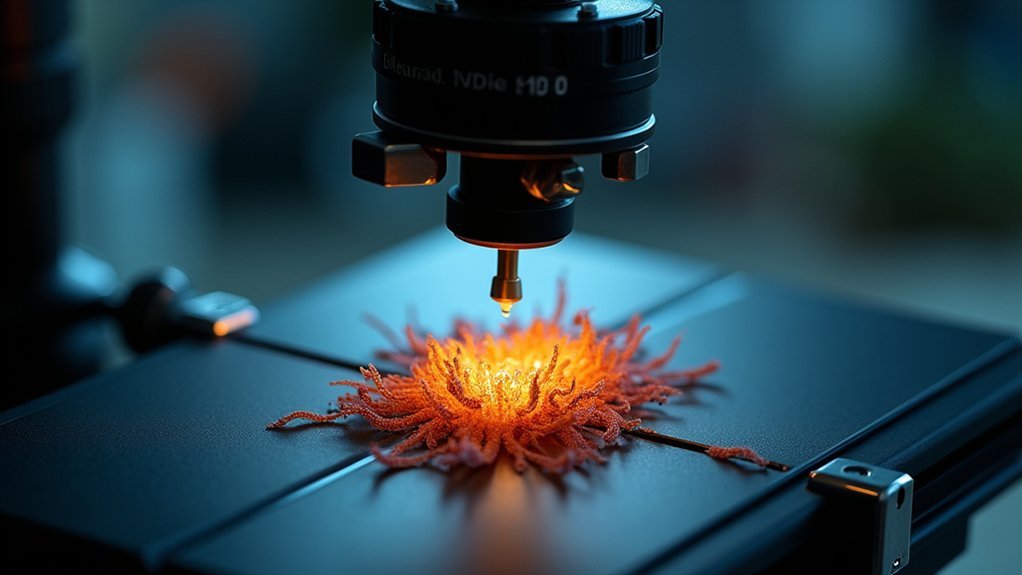Your samples are moving during photography due to several key factors: environmental vibrations, inadequate slide preparation, or improper camera settings. Vibrations from nearby equipment, foot traffic, or even air conditioning can disrupt high-magnification imaging. Your microscope stage might lack sufficient stability, while biological samples may move naturally if not properly fixed. The solutions involve proper mounting techniques, vibration-dampening equipment, and appropriate shutter speeds to capture crystal-clear microscopic images.
Numeric List of Second-Level Headings

When you’re troubleshooting why your samples appear to be moving during photography, understanding the core causes can help you solve the problem systematically.
Here’s what we’ll cover in this article:
- Understanding Motion Blur Fundamentals
- The Critical Role of Shutter Speed
- Common Technical Mistakes to Avoid
- Establishing Reference Points for Stability
- Mastering Panning Techniques
Most sample movement issues stem from slow shutter speed settings between 1/40th and 1/60th of a second. This creates motion blur that makes stationary objects appear to move.
You’ll need to address both your camera settings and shooting technique. Improper panning—moving too quickly while following your subject—can blur your samples while excessively blurring the background.
With practice, you’ll learn to balance shutter speed with proper technique to capture clear, crisp images of your samples without unwanted movement artifacts.
Understanding Vibration Sources in Microscope Photography
Although sample movement appears mysterious during microscope photography, vibration sources are often the hidden culprits behind your blurry images. When you’re dragging the shutter too long, your main subject becomes susceptible to even minor disturbances.
External factors like nearby equipment, foot traffic, and air conditioning units can all transmit vibrations to your microscope setup.
Don’t overlook the microscope itself—mechanical components including stage movement and focus mechanisms introduce their own vibrations.
You can combat these issues by:
- Using a sturdy, vibration-dampening table that isolates your microscope from environmental disturbances
- Increasing your shutter speed to freeze the image before vibrations affect clarity
- Implementing post-processing stabilization software to rescue slightly compromised images
Proper Slide Preparation Techniques for Stable Imaging

Proper slide mounting forms the foundation of stable microscopy imaging, requiring you to secure your specimen firmly without introducing artifacts that might compromise your results.
You’ll need effective strategies to counter liquid evaporation, which can cause currents that disturb delicate samples during critical photography sessions.
Specialized fixation methods, including chemical fixatives and physical restraints tailored to your specific sample type, can dramatically improve stability when standard mounting techniques prove insufficient.
Slide Mounting Best Practices
The foundation of stable microscopy imaging begins with meticulous slide preparation. When your camera moved during previous attempts, you likely noticed frustrating differences between the two images. Proper mounting eliminates these inconsistencies and guarantees reliable results.
Select high-quality slide mounts that securely grip your film without allowing even microscopic movement. Ascertain uniform alignment across all slides to maintain consistent perspective and framing. Place your setup on a vibration-free surface—even minor tremors can ruin your images.
- Your research credibility depends on crystal-clear, reproducible images
- Nothing wastes more valuable lab time than having to reshoot samples due to preventable motion blur
- Perfect slide mounting transforms frustrating imaging sessions into efficient, productive workflows
Clean slides meticulously before mounting to eliminate dust or fingerprints that compromise image clarity.
Preventing Liquid Evaporation
When liquid specimens evaporate during photography, they don’t just compromise image quality—they fundamentally alter your sample’s composition. This disruption causes unwanted movement and distorts your results.
To combat evaporation, seal your samples in airtight containers or use covers that minimize air exposure. Consider switching to higher viscosity liquids or adding stabilizing agents that slow evaporation rates while maintaining sample integrity.
Control your imaging environment’s temperature, as cooler conditions greatly reduce evaporation speed. When possible, employ quick imaging techniques with faster shutter speeds to minimize exposure time before capturing your shot.
For extended imaging sessions, regularly check and replenish liquid levels to guarantee consistent sample conditions.
These preventative measures will help you achieve stable, accurate imaging results every time.
Specialized Fixation Methods
Beyond managing evaporation, mastering specialized fixation methods forms the backbone of stable microscopic photography. Confirm your samples are adequately fixed to slides using mounting media that create strong bonds between specimens and slide surfaces. This stabilization process isn’t instantaneous—allow sufficient time for complete fixation to prevent sample movement and distortion in your final images.
Select appropriately sized coverslips that fit perfectly over your specimen. Properly fitted coverslips keep samples precisely positioned during photography sessions, eliminating frustrating shifts that ruin your documentation.
- Crisp, publication-quality images that showcase your meticulous attention to detail
- Reproducible results that save you countless hours of repeated imaging attempts
- Professional credibility among peers who recognize properly prepared microscopy work
Don’t forget to place your equipment on anti-vibration tables for additional stability during image capture.
Advanced Sample Mounting Methods to Prevent Movement

Securing your samples effectively during photography can mean the difference between crisp, professional images and frustrating, blurry results.
Try utilizing weighted mounts for your specimens—this added mass greatly counteracts vibrations that often occur during shooting sessions.
For smaller samples, employ adhesive putty or double-sided tape to anchor them firmly to your surface. When consistency is critical, implement custom jigs or fixtures to maintain identical positioning across multiple shots.
Don’t overlook your working surface—place vibration-dampening pads beneath your entire setup to absorb external disturbances that might compromise image quality.
When capturing motion studies, work in low-light conditions with longer shutter speeds, but make sure your samples remain securely mounted to prevent unwanted blur from ruining your shots.
Selecting the Right Microscope Stage for Steady Observation
When photographing microscopic samples, you’ll find that stability matters most in your stage selection, as even tiny movements can blur your images.
Magnetic holders work exceptionally well for securing slides and preventing drift during extended observation sessions.
Vibration-dampening materials are essential components of quality microscope stages, absorbing external disturbances before they reach your specimen.
Stability Matters Most
Three critical factors determine the quality of your microscopic photography, and stability tops the list. Your microscope stage serves as the foundation for clear, focused images.
When you’re capturing microscopic details, even nanometer movements can cause significant blurring, rendering your work unusable.
Choose a stage constructed with heavy-duty, rigid materials that absorb rather than transmit vibrations. Mechanical stages offer precise adjustments without disturbing your specimen’s position.
Always secure your samples firmly using appropriate clamps or adhesives to prevent shifting during observation.
- That moment when your perfectly focused specimen suddenly blurs as you reach for the camera
- The frustration of losing hours of preparation because of an unstable platform
- The professional satisfaction when your images remain crystal clear throughout an entire photography session
Magnetic Holders Work
Since stability remains your top priority, magnetic holders offer an elegant solution to common specimen movement issues. They provide the ideal balance of security and accessibility, firmly anchoring samples to your microscope stage while allowing quick adjustments when needed.
When selecting a stage, look for adjustable magnetic systems that match your specimen’s weight and dimensions. The magnetic strength should be sufficient to keep your sample immobile during photography without being overpowering for delicate materials.
A flat stage surface maximizes contact with magnetic holders, preventing unwanted tilting or shifting that could blur your images.
Consider investing in advanced stages with integrated magnetic systems if you work with diverse sample types. These versatile platforms accommodate various specimens while maintaining the stability essential for clear, consistent imaging results.
Vibration-Dampening Materials Essential
Microscopic photography demands absolute stillness, yet even the subtlest environmental vibrations can transform crisp images into blurry disappointments. Your choice of microscope stage plays an essential role in achieving stable observations.
Opt for stages with built-in vibration damping features that incorporate materials like rubber or foam to isolate your samples from external disturbances.
Don’t overlook the importance of your microscope’s overall weight—heavier setups naturally resist vibrations better than lightweight alternatives.
Position your equipment on a solid, isolated work surface to prevent transmitted vibrations, and maintain your microscope regularly to eliminate loose components that might compromise stability.
- Watching your carefully prepared sample drift away during the perfect shot is truly heartbreaking
- The frustration of repeating observations due to unstable equipment wastes precious research time
- The satisfaction of capturing perfectly clear, publication-worthy images is worth the investment
Environmental Factors Affecting Sample Stability
When shooting samples in controlled environments, you might still encounter unexpected movement that ruins your perfect shot. Wind is a primary culprit, especially for outdoor photography—secure your specimens or use windbreaks to minimize this disruption.
Nearby traffic or machinery creates vibrations that travel through surfaces to your setup. Place your photography station on stable platforms isolated from these disturbances.
Temperature fluctuations cause materials to expand or contract subtly during capture, particularly noticeable in close-up work.
Similarly, changing humidity levels introduce moisture to organic samples, altering their texture and stability.
Don’t overlook your lighting setup—flickering artificial lights create the illusion of movement through rapid exposure changes. Opt for consistent, steady light sources to maintain clarity and prevent perceived motion in your sample photographs.
Camera Settings to Compensate for Minimal Movement

Even the steadiest hands can’t eliminate all movement during sample photography, but your camera settings can make a significant difference in capturing clear images. Start with a shutter speed of at least 1/60th of a second to freeze motion and reduce blur. In low-light conditions, adjust your ISO higher to maintain faster shutter speeds, and experiment with aperture settings to balance exposure and prevent motion blur.
- Activate image stabilization features on your camera and lenses—you’ll feel tremendous relief when you see how much clearer your sample images become.
- Switch to continuous autofocus (AF-C) mode when photographing moving specimens—you’ll love watching your camera track even subtle movements.
- Master the exposure triangle (shutter speed, ISO, aperture)—you’ll experience newfound confidence when tackling challenging photography scenarios.
Anti-Vibration Equipment for Professional Microscopy
Professional microscopy demands absolute stability to capture precise images, which is why anti-vibration equipment has become essential in laboratory settings.
These specialized tools provide a stable platform that minimizes external vibrations that would otherwise distort your high-magnification images.
You’ll find two main types of systems: passive solutions using air or mechanical dampening, and advanced active systems that employ sensors to detect and counteract vibrations in real-time.
The latter offers superior stabilization for your most sensitive applications.
Frequently Asked Questions
Why Do Some Images Look Like They Are Moving?
Images appear to move due to motion blur when you’re using slow shutter speeds, panning techniques, or intentional camera movement. Your perception also interprets blur as motion, especially when it creates dynamic contrast or energy.
What Is a Moving Image in Photography?
In photography, a moving image is when you’ve captured motion blur while keeping your subject sharp. You’ll use techniques like panning or slow shutter speeds to create this dynamic effect that conveys energy and movement.
What Is the Motion Effect in Photography?
The motion effect in photography is a technique you’ll use to capture dynamic movement. You’re manipulating shutter speed to create intentional blur that conveys speed and action within your still images.
What Is It Called When a Photo Moves?
When a photo appears to move, it’s called “motion blur.” You’re seeing the result of movement during exposure. This can be intentional for artistic effect or unintentional if your camera wasn’t steady enough.
In Summary
By identifying vibration sources and implementing proper preparation techniques, you’ll dramatically improve your microscopy results. Don’t overlook your microscope stage quality and environmental factors like airflow and temperature. Optimize your camera settings for faster exposures and consider investing in anti-vibration equipment for the most critical work. With these adjustments, you’ll capture crisp, clear images without the frustration of blurry, moving samples.





Leave a Reply